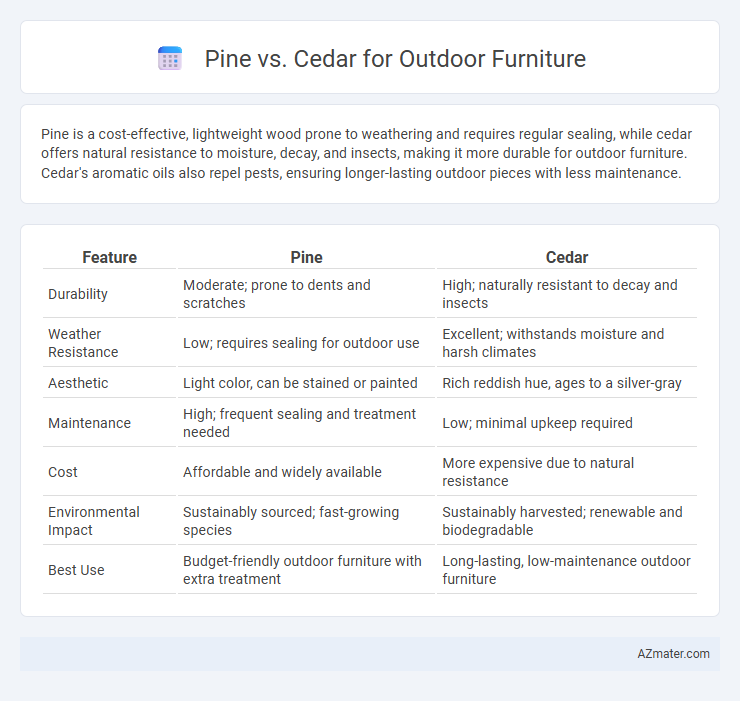Pine is a cost-effective, lightweight wood prone to weathering and requires regular sealing, while cedar offers natural resistance to moisture, decay, and insects, making it more durable for outdoor furniture. Cedar's aromatic oils also repel pests, ensuring longer-lasting outdoor pieces with less maintenance.
Table of Comparison
| Feature | Pine | Cedar |
|---|---|---|
| Durability | Moderate; prone to dents and scratches | High; naturally resistant to decay and insects |
| Weather Resistance | Low; requires sealing for outdoor use | Excellent; withstands moisture and harsh climates |
| Aesthetic | Light color, can be stained or painted | Rich reddish hue, ages to a silver-gray |
| Maintenance | High; frequent sealing and treatment needed | Low; minimal upkeep required |
| Cost | Affordable and widely available | More expensive due to natural resistance |
| Environmental Impact | Sustainably sourced; fast-growing species | Sustainably harvested; renewable and biodegradable |
| Best Use | Budget-friendly outdoor furniture with extra treatment | Long-lasting, low-maintenance outdoor furniture |
Introduction to Pine and Cedar Outdoor Furniture
Pine outdoor furniture offers affordability, lightweight ease, and a natural, rustic charm that blends well with various garden styles. Cedar furniture stands out for its natural resistance to decay, insects, and moisture, making it highly durable and low-maintenance in outdoor conditions. Both woods provide unique aesthetics and functional benefits, with pine's softer texture contrasting cedar's distinctive aroma and reddish hue.
Key Characteristics of Pine Wood
Pine wood, commonly used for outdoor furniture, is lightweight and easy to work with due to its softwood classification. Its natural resin content offers moderate resistance to moisture and decay; however, it often requires protective treatments like sealants or stains to enhance durability. Pine's pale color and visible grain patterns provide a rustic aesthetic but may yellow over time when exposed to sunlight.
Key Characteristics of Cedar Wood
Cedar wood is prized for its natural resistance to decay, insects, and moisture, making it an ideal choice for outdoor furniture exposed to various weather conditions. Its lightweight yet durable structure allows for easy handling and long-lasting performance, while the aromatic oils in cedar provide a pleasant scent and act as a natural preservative. Cedar's rich reddish-brown hue and fine grain texture enhance aesthetic appeal, requiring minimal maintenance compared to pine, which tends to be more prone to warping and insect damage.
Durability: Pine vs Cedar in Outdoor Conditions
Cedar outperforms pine in outdoor durability due to its natural resistance to rot, decay, and insect damage, making it ideal for furniture exposed to moisture and harsh weather. Pine, a softer wood, requires regular sealing and treatment to withstand outdoor conditions and prevent warping or rotting. Cedar's tight grain and natural oils contribute to its longer lifespan in outdoor environments compared to the more porous and absorbent nature of pine.
Resistance to Weather, Rot, and Insects
Pine outdoor furniture is more affordable but requires regular treatment to resist weather, rot, and insect damage, as it is naturally softer and more porous. Cedar offers superior resistance to moisture, decay, and insect infestations due to its natural oils and dense grain, making it ideal for long-lasting outdoor use. Choosing cedar reduces maintenance needs and prolongs furniture life compared to untreated or inadequately treated pine.
Maintenance Requirements for Pine and Cedar
Pine outdoor furniture requires regular sealing or staining every one to two years to protect against moisture and weather damage, as it is more prone to rot and insect infestation. Cedar, naturally resistant to decay and insects due to its natural oils, demands less frequent maintenance, typically needing only an annual application of a protective finish to preserve its appearance and durability. Both woods benefit from periodic cleaning to remove dirt and mildew, but cedar's inherent resilience makes it a low-maintenance option for outdoor use.
Cost Comparison: Pine vs Cedar Furniture
Pine outdoor furniture typically costs less than cedar, making it a budget-friendly option for many homeowners. Cedar furniture, while more expensive, offers natural resistance to rot and insects, which can reduce long-term maintenance expenses. Investing in cedar may result in higher upfront costs, but it generally provides greater durability and longevity compared to pine.
Aesthetic Differences: Appearance and Color
Pine outdoor furniture typically features a light, creamy yellow tone that can develop a warm honey hue with age, offering a bright and rustic aesthetic ideal for casual or country-style settings. Cedar exhibits a rich reddish-brown color with natural variations and a smooth grain pattern that enhances its refined and elegant appearance, making it a popular choice for upscale outdoor decor. The distinct color contrast between pine's pale, soft look and cedar's deep, vibrant hues allows homeowners to select a wood species that aligns with their desired visual impact and outdoor ambiance.
Environmental Impact and Sustainability
Pine and cedar both offer sustainable options for outdoor furniture, but cedar is naturally more resistant to decay and insects, reducing the need for chemical treatments and extending furniture lifespan. Pine grows faster and is more readily available, making it a renewable choice, though it often requires protective finishes to enhance durability outdoors. Choosing FSC-certified pine or cedar ensures responsible forest management, minimizing environmental impact while supporting sustainable furniture production.
Final Verdict: Choosing the Best Wood for Outdoor Furniture
Cedar outperforms pine for outdoor furniture due to its natural resistance to moisture, decay, and insect damage, ensuring longer durability with minimal maintenance. Pine, while more affordable and easier to work with, requires regular sealing and treatment to withstand outdoor conditions effectively. For long-term investment and weather resilience, cedar is the superior choice, offering enhanced longevity and aesthetic appeal in outdoor settings.

Infographic: Pine vs Cedar for Outdoor Furniture
 azmater.com
azmater.com